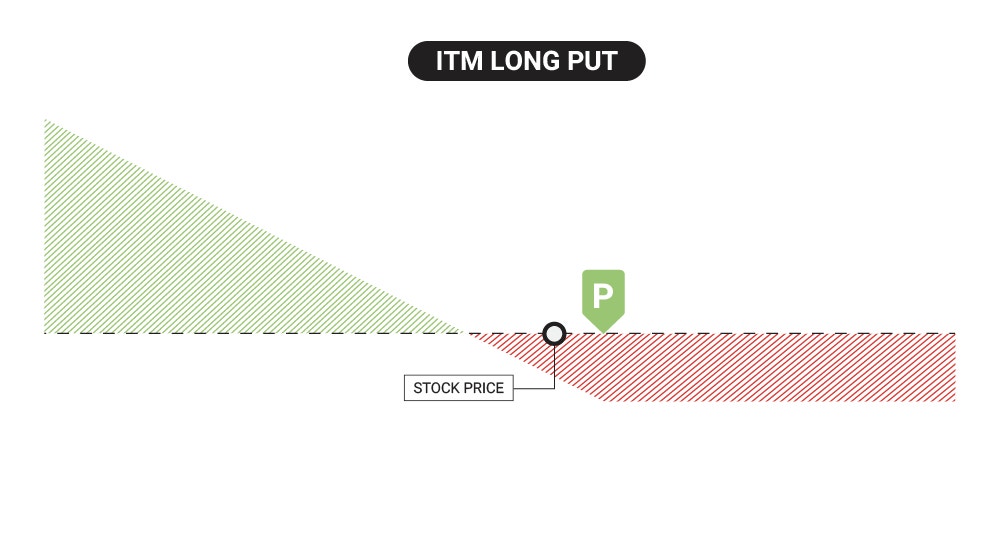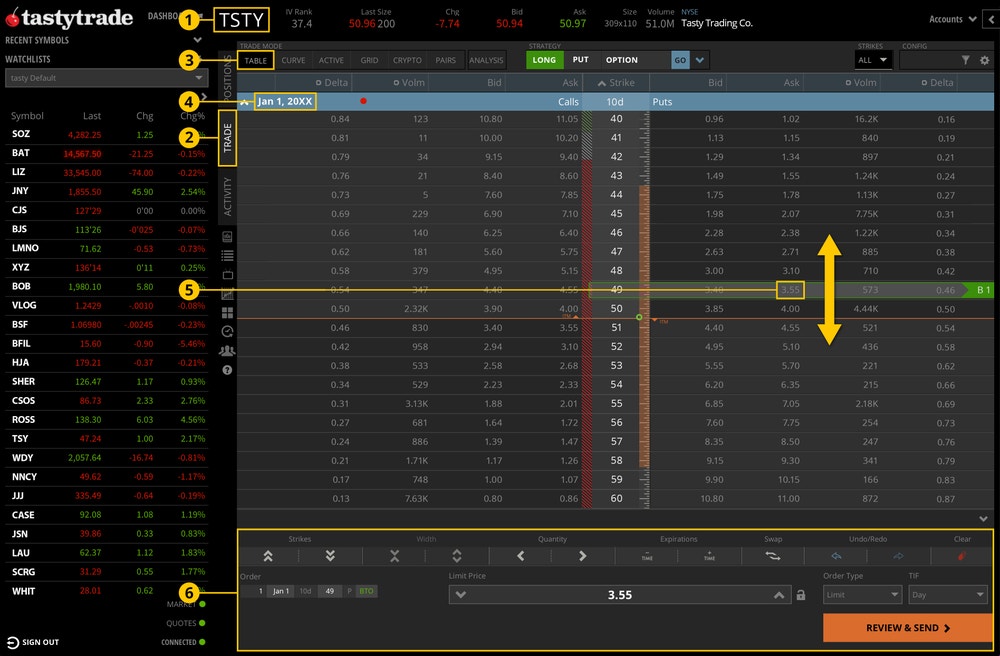Long Put Options Strategy Explained
Long Put Summary
- When purchasing a put option, a bearish strategy, you have the right but not obligation to sell 100 shares of the underlying asset at the strike price on or before the expiration date.
- The value of a put option can appreciate as the price of the underlying asset drops and approaches the strike price.
- Out-of-the-money (OTM) puts are usually cheaper than in-the-money (ITM) puts due to the extrinsic value they hold. However, ITM puts have intrinsic and extrinsic value, resulting in a higher cost per contract.
Long Put Option
Purchasing a put option gives you the right, not the obligation, to sell 100 shares of the underlying asset at the strike price on or before the expiration date. The put option value will appreciate as the price of the stock or ETF drops and approaches your strike price. Therefore, it’s a bearish strategy. Conversely, the value of a put option will depreciate when the price of the underlying it tracks rises or remains constant due to time decay.

Buying puts can be a less capital-intensive way to gain short exposure to the shares without short-selling shares outright. However, long options suffer from time decay, and the value may decrease each day the underlying does not move toward the strike price. As a result, the underlying must drop at a greater velocity towards the put options' strike price to make up for lost value.
Out-of-the-money (OTM) puts are usually cheaper than in-the-money (ITM) puts. That is because the value of an OTM put is entirely made up of extrinsic value. ITM puts will have intrinsic and extrinsic value, resulting in a higher cost per contract. Over time, the extrinsic value of all options decays to $0 as expiration approaches. Meanwhile, ITM puts will retain their intrinsic value at expiration, and any extrinsic value will decay down to $0 near or at expiration.
The ideal scenario of a long ITM put option is to have the underlying drop as much as possible, so it gains intrinsic value and is worth more at expiration than what the trader purchased the put option for upfront. This is the same scenario for OTM put options as well, since OTM put options need to move ITM at expiration to retain any value at all. Prior to expiration, OTM and ITM put options can gain extrinsic and/or intrinsic value if the stock moves swiftly to the downside as well.
Long put options that expire ITM by $0.01 or more will be auto-exercised. Investors only holding a long put will result in 100 short shares* per contract sold at the put option's strike price. Investors holding the corresponding long shares will sell their long shares at the put contract's strike price. It's important to note that investors who want to avoid the long put contract from auto-exercising for expiring ITM may sell the contract before the market closes on the expiration day. Any long put options that expire OTM will expire worthless, resulting in a maximum loss for the investor. The following section covers more about potential profit and loss of a long put.
*Only non-IRA margin accounts with the highest trading level, "The Works," that have sufficient account equity may hold and maintain a short stock position. Any account holding a long put subject to expiration risk may be closed out by the tastytrade risk team. Please visit the tastytrade Help Center to learn more about expiration risk.
Profit & Loss Diagram of Purchasing an OTM Long Put
A long OTM put becomes profitable when the current value of the option exceeds the purchase price. This can occur prior to expiration if the stock moves towards the strike and increases the extrinsic or intrinsic value of the option, or at expiration if the stock moves well below the strike price. The max profit of a long put is not unlimited, unlike a long call, since the most a stock can drop is to $0.
Losses on the put option can occur if the underlying does not surpass the breakeven point, as illustrated where the red and green zone converge on the x-axis. The breakeven point can be calculated at expiration by taking the strike price and subtracting the purchase price of the OTM option. Since OTM options are purely made up of extrinsic value, the strike needs to move ITM and take on an equivalent amount of intrinsic value at expiration to breakeven.
The maximum loss on a long put is the debit paid for the option, which the flattened red area of the diagram illustrates.

Profit & Loss Diagram of Purchasing an ITM Long Put
A unique characteristic of ITM options is that the price of the option will actively gain and lose intrinsic value 1:1 with the underlying. Although purchasing an ITM option has intrinsic value, it does not necessarily mean it is instantly profitable or profit is guaranteed. Like buying an OTM put, the underlying must drop more than the debit paid from its strike price for the long put to be profitable, as illustrated where the red and green zones converge on the x-axis. If starting with an ITM put, the option still has extrinsic value, so if the stock price doesn’t move at all, the option will still lose extrinsic value.
The maximum loss on a long put is the debit paid for the option, which the flattened red area of the diagram illustrates.

Example of Purchasing an OTM Long Put
XYZ trading @ $55
- Buy to Open +1 XYZ 50-strike put @ $3 debit
Paid a $3 debit ($300 total)
Factor | Explanation |
|---|---|
Time Decay Affect | Works against the option’s value |
Max Profit | (Put strike price x 100 standard options multiplier) - Total debit paid ($50 put strike price x 100) - $300 total debit = $4,700 |
Max Loss | Total debit paid $300 |
Breakeven Price | Strike price – Debit price $50-$3= $47 |
Buying Power Requirement | Debit paid $300 |
Account Type Required | Cash, Margin, and IRA |
Factor | Explanation |
|---|---|
Time Decay Affect | Works against the option’s value |
Max Profit | (Put strike price x 100 standard options multiplier) - Total debit paid ($50 put strike price x 100) - $300 total debit = $4,700 |
Max Loss | Total debit paid $300 |
Breakeven Price | Strike price – Debit price $50-$3= $47 |
Buying Power Requirement | Debit paid $300 |
Account Type Required | Cash, Margin, and IRA |
Example of Purchasing an ITM Long Put
XYZ trading @ $55
- Buy to Open +1 XYZ 60-strike put @ $8 debit ($5 intrinsic value + $3 extrinsic value)
Paid a $8 debit ($800 total)
Factor | Explanation |
|---|---|
Time Decay Affect | Works against the option’s value |
Max Profit | (Put strike price x 100 standard options multiplier) - Total debit paid ($60 put strike price x 100) - $800 total debit = $5,200 |
Max Loss | Total debit paid $800 |
Breakeven Price | Strike price – Debit price $60-$8 = $52 |
Buying Power Requirement | Debit paid $800 |
Account Type Required | Cash, Margin, and IRA |
Factor | Explanation |
|---|---|
Time Decay Affect | Works against the option’s value |
Max Profit | (Put strike price x 100 standard options multiplier) - Total debit paid ($60 put strike price x 100) - $800 total debit = $5,200 |
Max Loss | Total debit paid $800 |
Breakeven Price | Strike price – Debit price $60-$8 = $52 |
Buying Power Requirement | Debit paid $800 |
Account Type Required | Cash, Margin, and IRA |
How to Buy a Long Put
Using the Strategy Menu
- Enter a symbol.
- Navigate to the Trade tab.
- Go to the Table mode.
- Click on an Expiration Date to expand.
- Click the Strategy Menu.
- Locate the Option strategy and (from left to right) click each column to display Long, Put, and Go.
- Go to the order ticket to determine the quantity, price, time-in-force (TIF), etc., before clicking Review and Send. Review the order thoroughly including commissions and fees, then send the order.

Building it Manually
- Enter a symbol.
- Navigate to the Trade tab.
- Go to the Table mode.
- Click on an Expiration Date to expand.
- Click on the Ask price of the put you want to buy.
- Go to the order ticket to determine the quantity, price, time-in-force (TIF), etc., before clicking Review and Send. Review the order thoroughly including commissions and fees, then send the order.

Options involve risk and are not suitable for all investors as the special risks inherent to options trading may expose investors to potentially significant losses. Please read Characteristics and Risks of Standardized Options before deciding to invest in options.
All investments involve risk of loss. Please carefully consider the risks associated with your investments and if such trading is suitable for you before deciding to trade certain products or strategies. You are solely responsible for making your investment and trading decisions and for evaluating the risks associated with your investments.